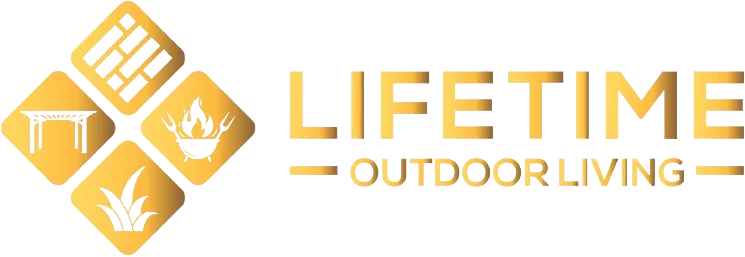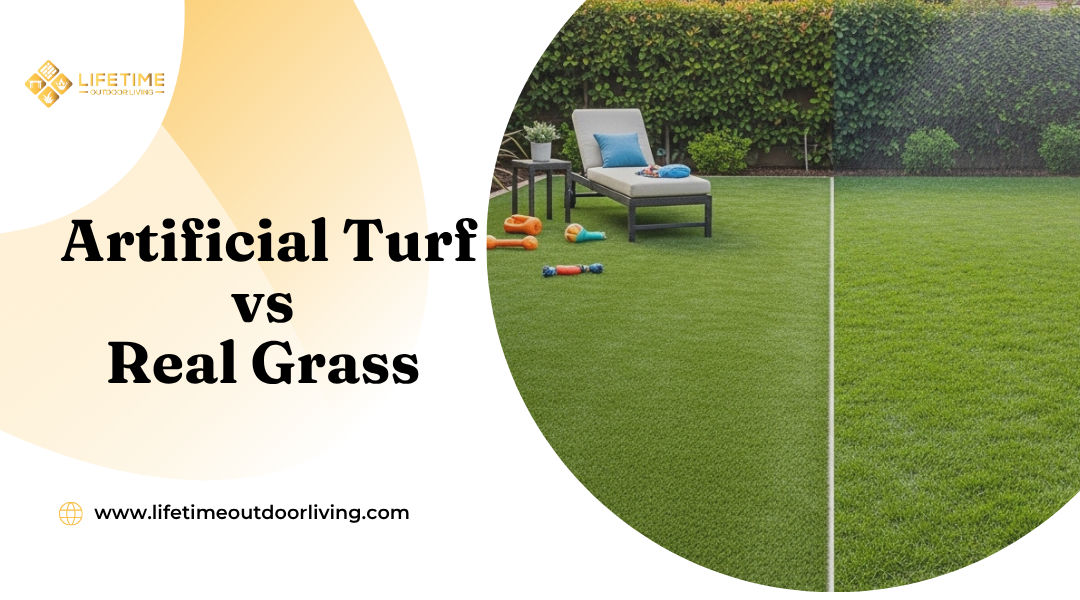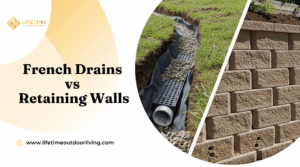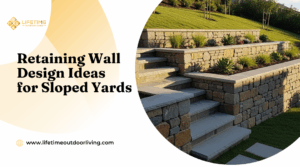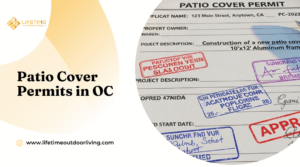When deciding between artificial turf and real grass for Orange County lawns, the best choice depends on maintenance preferences, water use, and the specific needs of the outdoor space. Artificial turf offers low upkeep and water savings, while natural grass provides a traditional look and natural cooling benefits.
Lifetime Outdoor Living, a reputable paving contractor in Laguna Beach, California, helps homeowners weigh these factors to find the ideal solution. Their expertise ensures each lawn upgrade balances aesthetics, functionality, and long-term value tailored to Orange County’s climate and lifestyle.
Whether clients prioritize convenience and durability or the feel of authentic grass, Lifetime Outdoor Living guides them through options that suit their property and personal goals. This comparison will clarify which lawn type fits best for those looking to enhance their outdoor living spaces.
Climate Considerations In Orange County
Orange County’s climate impacts lawn choices significantly, from water availability to sunlight exposure and soil diversity. Homeowners must account for these factors when deciding between artificial turf and real grass.
Drought Conditions And Water Restrictions
Orange County frequently experiences drought, prompting strict water restrictions. Many residents face limits on irrigation days and daily watering times to conserve water.
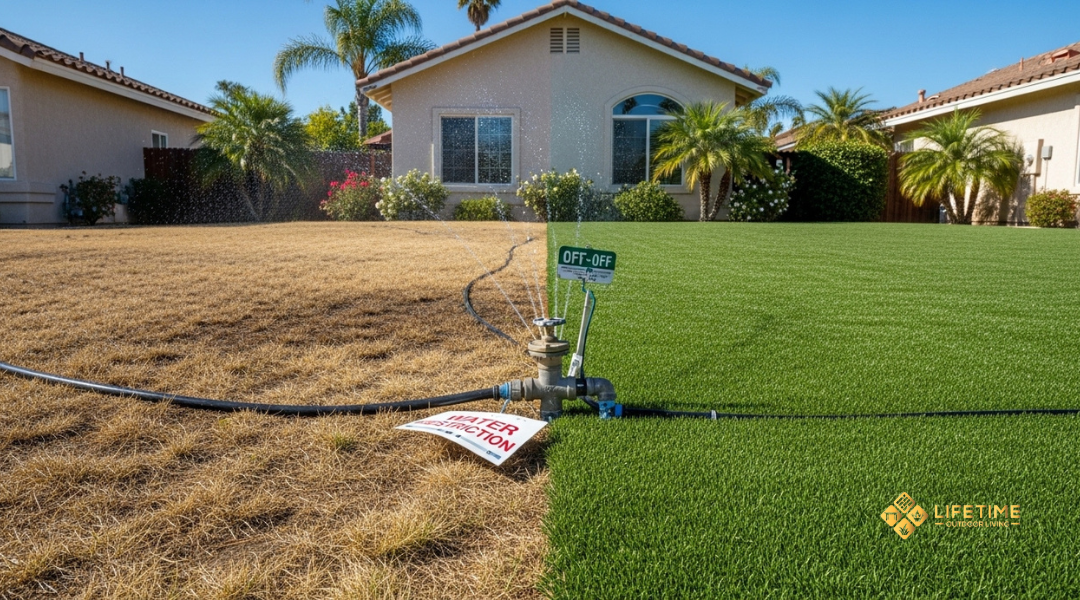
Real grass lawns require substantial water, especially in summer months, increasing utility costs. Artificial turf eliminates watering needs, offering a consistent green appearance without added water use.
Water conservation measures make artificial turf appealing in times of drought. However, some drought-tolerant grass varieties can survive with reduced irrigation, though they may brown during extreme shortages.
Year-Round Sunshine: Opportunities And Challenges
Orange County enjoys about 280 sunny days per year. This abundant sunlight supports vigorous grass growth but also leads to high evaporation rates.
Real grass benefits from sunlight for photosynthesis but needs frequent watering to stay healthy in intense sun. Shade from trees or structures can create uneven lawn conditions in some yards.
Artificial turf maintains a uniform look regardless of sun exposure. Yet, it can absorb and retain heat more than natural grass, potentially making it hotter on warm days.
Soil Types And Lawn Performance In Coastal Vs Inland Areas
Coastal soils in Orange County tend to be sandy with good drainage but low nutrient retention. These conditions require soil amendments and fertilizers for healthy grass.
Inland areas often have clay or loamy soils, which retain moisture and nutrients better but may have drainage issues. Grass selection must consider these soil types for optimal growth.
Artificial turf installation is less affected by soil type, though proper base preparation is critical for drainage and surface stability. Real grass performance varies widely based on local soil conditions.
Artificial Turf: Pros And Cons For SoCal Lawns
Artificial turf offers several practical advantages but also presents challenges that homeowners in Southern California should consider. Its benefits include reduced upkeep and water savings, while some drawbacks involve heat management and upfront costs. Specific use cases reveal where it performs best.
Key Benefits: Low Maintenance, Water Savings, And Durability
Artificial turf requires minimal upkeep compared to natural grass. There is no need for mowing, fertilizing, or regular watering, which can save significant time and effort.
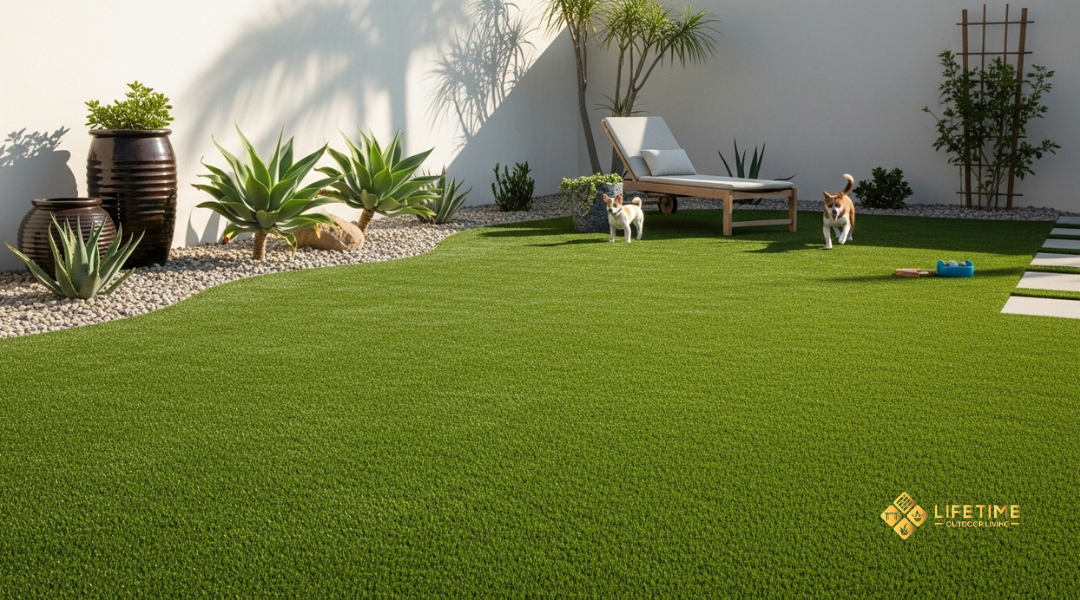
Water conservation is a key advantage in Southern California’s drought-prone areas. Using turf can reduce outdoor water use by thousands of gallons annually.
Durability is high; quality turf withstands heavy foot traffic and harsh weather without wearing down quickly. It maintains a uniform green appearance throughout the year regardless of rainfall or temperature changes.
Common Concerns: Heat Retention, Initial Cost, And Aesthetic Preferences
Artificial turf can retain heat and become uncomfortably warm on hot Southern California days. Surface temperatures can exceed natural grass by 20-30 degrees Fahrenheit.
The initial installation cost is higher than seeding or sod. It requires investment upfront but lowers maintenance expenses over time.
Aesthetic opinions vary; some find turf less natural in look and feel compared to real grass. The texture and color options have improved but might still not satisfy all preferences.
Best Use Cases: Pet Owners, Kids’ Play Areas, And Rental Properties
Artificial turf suits pet owners because it resists damage from digging and is easier to clean than natural grass.
Play areas for children benefit from a consistently soft and stable surface that doesn’t develop bald patches or mud during rain or heavy use.
Rental properties gain value from turf by reducing lawn care responsibilities and enhancing curb appeal with a low-maintenance solution that looks good year-round.
Real Grass: Pros And Cons For SoCal Lawns
Real grass offers a classic aesthetic and environmental benefits that many homeowners appreciate. However, it also demands consistent care and significant water resources, which are important considerations in Southern California.
Advantages: Natural Look, Environmental Benefits, And Cooling Effect
Real grass provides a natural, lush appearance that complements the outdoor space in Orange County. It creates a soft, inviting surface for activities and blends well with native plants.
Grass naturally filters air pollutants and produces oxygen. It also absorbs carbon dioxide, which helps reduce greenhouse gases locally. This contributes to a healthier outdoor environment.
One notable benefit is the cooling effect grass offers. It lowers surface temperatures by up to 30°F compared to artificial turf or concrete, helping to combat heat in SoCal’s warm climate.
Drawbacks: High Water Use, Ongoing Maintenance, And Pest Issues
Maintaining a green lawn in Orange County requires substantial water—often 20-50 gallons per square foot weekly during dry months. This can strain local water resources.
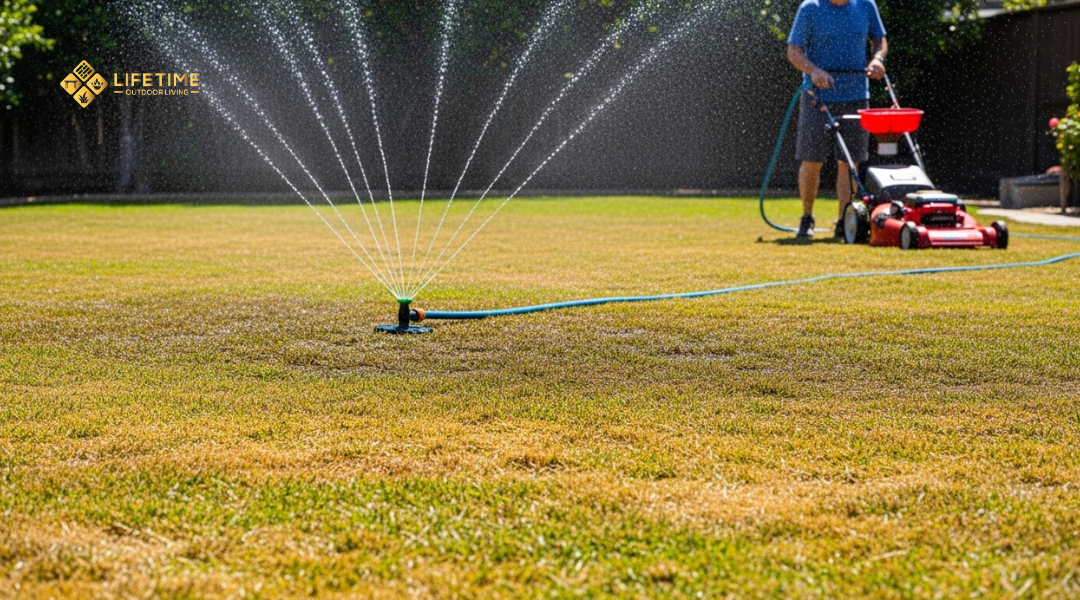
Regular upkeep involves mowing, fertilizing, aerating, and treating pests. These tasks demand time, effort, and some expense over the year.
Grass also attracts insects such as ants, beetles, and occasional grubs. Homeowners must monitor and manage these pests to prevent damage or discomfort.
Types Of Grass That Perform Best In Orange County (E.g., Bermuda, St. Augustine)
Bermuda grass is popular due to its drought tolerance and ability to withstand heavy foot traffic. It thrives in full sun but may go dormant and brown during extreme drought.
St. Augustine grass prefers shaded or partly shaded areas and adapts well to coastal climates. It requires moderate watering and shows good resistance to pests.
Other options like Zoysia offer a dense, carpet-like texture but need less frequent mowing. Choosing the right type depends on the lawn’s sun exposure, soil, and water availability.
| Grass Type | Sun Exposure | Water Needs | Maintenance Level | Pest Resistance |
| Bermuda | Full sun | Low to moderate | Moderate | Moderate |
| St. Augustine | Shade to partial | Moderate | Moderate | Good |
| Zoysia | Full sun to light shade | Low | Low to moderate | Moderate |
Cost Comparison: Short-Term Vs Long-Term Investment
Evaluating artificial turf against real grass involves understanding both initial expenses and ongoing costs. Additionally, the impact on property value and return on investment (ROI) plays a key role in decision-making for Orange County homeowners.
Installation Costs For Turf Vs Sod Or Seed
Artificial turf installation typically ranges from $8 to $15 per square foot. This includes base preparation, turf material, and labor. Initial costs are higher compared to real grass.
Sod installation costs are about $1 to $2 per square foot but require soil preparation and regular watering to ensure establishment. Seeding is cheaper upfront, around $0.10 to $0.20 per square foot, but grows slowly and may need reseeding.
Artificial turf offers immediate, consistent coverage, while real grass may need weeks to become fully functional. The price difference favors real grass in the short term but shifts when considering maintenance.
Ongoing Maintenance And Utility Expenses Over Time
Artificial turf requires minimal maintenance: occasional rinsing, debris removal, and infill replenishment every few years. There is no mowing, fertilizing, or watering, reducing labor and utility bills significantly.
Real grass demands regular mowing, fertilizing, pest control, and substantial irrigation in Orange County’s dry climate. Water bills can increase by hundreds of dollars per month during summer, adding to long-term costs.
Annual maintenance costs for real grass can range from $500 to over $1,000, depending on lawn size and care frequency. Turf maintenance remains under $100 annually on average.
ROI And Property Value Impact
Artificial turf can enhance curb appeal with a perfectly green appearance year-round, potentially attracting certain buyers seeking low-maintenance landscaping. However, traditional buyers often value natural grass for its aesthetic and environmental benefits.
Real grass may modestly increase property value due to perceived natural beauty and cooling effects but requires time and care to maintain attractiveness.
The ROI on artificial turf can justify higher upfront costs through savings on water, maintenance, and labor expenses over 10-15 years. Real grass may offer lower initial costs but comes with ongoing financial and time commitments.
Environmental Impact And Sustainability
The choice between artificial turf and real grass significantly affects water usage, maintenance cycles, and waste management. Understanding these factors helps homeowners in Orange County make better decisions based on sustainability and environmental impact.
Water Conservation: Real Savings With Artificial Turf
Artificial turf requires no watering, which can save thousands of gallons annually compared to natural grass. In regions like Laguna Beach, where drought and water restrictions often apply, this is a key advantage.
Real grass lawns typically need about 55 inches of water per year, depending on climate and soil, leading to high water bills and resource use. Artificial turf eliminates this need entirely, reducing consumption and lowering water waste.
Water savings also reduce energy use related to water treatment and pumping. However, the initial environmental cost of manufacturing turf should be weighed against long-term water conservation benefits.
Turf’s Lifespan Vs Grass Renewal Cycles
Artificial turf usually lasts between 10 and 20 years depending on quality and usage. After this period, it must be replaced, involving disposal or recycling processes.
Real grass regenerates naturally each growing season but requires regular mowing, fertilizing, and pest control. These activities consume fuel and chemicals, contributing to emissions and environmental degradation.
Artificial turf’s stable surface avoids the need for herbicides and fertilizers but may suffer wear and fading over time. Grass requires ongoing care, impacting both time and environmental costs annually.
Recyclability And Eco-Friendly Turf Options
Most traditional artificial turf products are made from polyethylene or polypropylene, which are not biodegradable but can be recycled if facilities exist. Recycling rates vary by region, and improper disposal can contribute to landfill buildup.
Eco-friendly turf options use materials like recycled plastics or biodegradable infill to reduce environmental footprint. Some manufacturers offer take-back programs to handle end-of-life turf responsibly.
Homeowners should verify recycling options and product certifications to choose turf with lower environmental impact, especially in areas like Orange County where landfill space is limited.
Aesthetic And Functional Considerations
Choosing between artificial turf and real grass involves balancing appearance, comfort, and how well the surface works with other landscape elements. These factors impact the usability and feel of a lawn, especially in a climate like Orange County’s.
Visual Appeal: Natural Look Vs Uniform Finish
Real grass offers a varied color palette and texture that changes with seasons and sunlight. This natural inconsistency adds depth and softness to a lawn’s appearance. However, it can include brown patches or uneven growth without proper care.
Artificial turf provides a consistently green and manicured look year-round. Its uniform color and height create a tidy, low-maintenance finish, but may lack the subtle variations found in natural grass. Modern synthetic options often mimic grass blades to improve realism.
Comfort, Texture, And Use Underfoot
Real grass offers a soft, cool surface that typically feels comfortable to walk or play on. It can absorb impact better, which is beneficial for families with children or pets. However, soil conditions and weather can affect its firmness and dryness.
Artificial turf has a firmer texture and tends to retain heat in direct sunlight, which can make it less comfortable during hot days. Advances in turf pad underlays improve cushioning, but it still doesn’t match the natural feel of living grass.
Integration With Pavers, Walkways, And Outdoor Features
Real grass requires careful edging to prevent overgrowth onto pavers and walkways. Maintenance is ongoing to keep boundaries defined, which may involve trimming and watering.
Artificial turf installs with a stable underlying base, allowing cleaner edges and a neat fit against hardscapes. It resists erosion and does not grow into cracks or seams, reducing maintenance around outdoor features like patios or fire pits.
Lifetime Outdoor Living’s Turf Installation Process
Lifetime Outdoor Living focuses on precise planning, quality groundwork, and thoughtful integration of artificial turf with existing landscape features. This approach ensures durability, aesthetics, and a natural appearance suited for Orange County climates.
Design Consultation And Lawn Goals Assessment
The process begins with an on-site consultation where the team evaluates the property’s size, sunlight exposure, and soil conditions. They discuss the client’s preferences, usage patterns, and maintenance expectations to tailor solutions.
During this stage, they measure the area and identify any specific needs like pet-friendly turf or high-traffic durability. These details shape the turf selection and installation plan to meet both functional and visual criteria.
Professional Grading, Drainage & Base Prep
Proper grading is performed to create a level surface, ensuring water flows away from buildings and prevents pooling. The team installs a compacted base of crushed rock or decomposed granite to stabilize the turf and aid drainage.
They also implement a layered system: weed barrier fabric, base material, and then the artificial turf. This foundation prevents weed growth and supports longevity under frequent use and harsh weather.
Seamless Integration With Hardscape And Landscape Elements
The installation respects existing design elements such as patios, walkways, flower beds, and irrigation systems. Edges are carefully trimmed and anchored to blend the turf smoothly with concrete, stone, or wood features.
This integration avoids gaps and irregularities, maintaining clean lines and preventing turf from shifting. The finished lawn complements the outdoor living space both functionally and visually.
